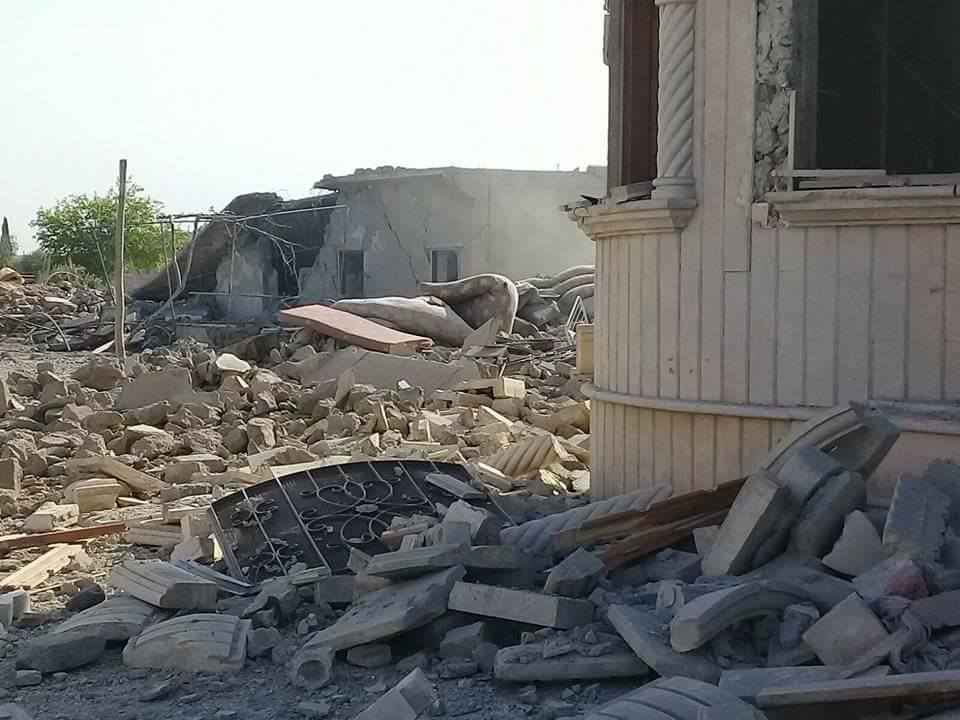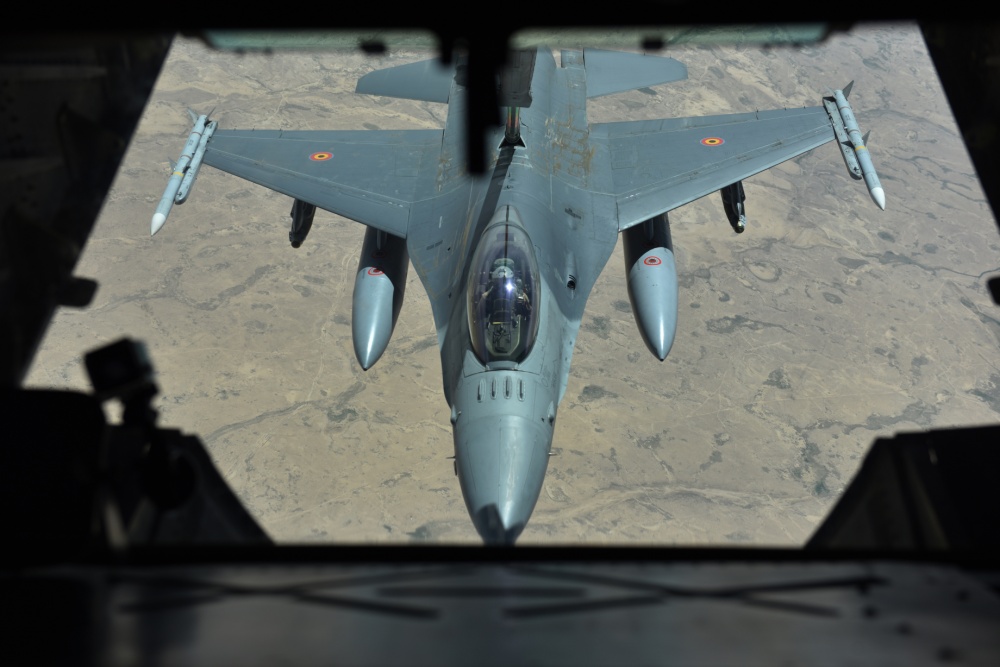Civilians are at increased risk of harm from US airstrikes under President Trump, months of data indicate

Airwars research team: Kinda Haddad, Latif Habib, Abdulwahab Tahhan, Shihab Halep, Eline Westra, Christiaan Triebert, Oliver Imhof, Poppy Bowers, Beth Heron, Samuel Oakford and Chris Woods
Civilians continued to pay a lethal price in April from the Coalition-backed campaigns to liberate both West Mosul and Raqqa. The volume of casualty incidents remained high, with 159 claimed events tracked across Iraq and Syria. However estimated likely deaths fell by 46% – mainly in the absence of March’s mass casualty incidents. Nevertheless, between 283 and 366 civilians likely died across Iraq and Syria according to our provisional assessment, making April the second worst month for civilian fatalities since Coalition actions began in August 2014.
The unprecedented recent toll meant that for the fourth consecutive month, civilian casualty incidents attributed to the Coalition in Iraq and Syria outweighed those reportedly involving Moscow in Syria. This higher number in April was only marginal, however After three months of scaled-back actions, Russia’s often brutal air campaign was once again building momentum, and casualty events increased by 36% from March. Ordinary Iraqis and Syrians remained in extreme danger from airstrikes by all belligerents.
“With three full months of airstrike and civilian casualty data from Donald Trump’s presidency, we are now seeing the emergence of clear trends,” says Director of Airwars Chris Woods. “Around Raqqa in particular – where most strikes are by the US – we are seeing high civilian casualties where six months ago we would not. This is the clearest evidence yet that protections for civilians on the battlefield appear to have been scaled back – with the inevitable consequence of higher deaths and injuries. As the battle for Raqqa itself approaches, we therefore remain extremely concerned for the fate of hundreds of thousands of civilians still trapped within the city.”
As of April 30th 2017, 12,553 airstrikes had been carried out in Iraq and 8,482 in Syria since the start of the Coalition campaign against so-called Islamic State. During April, 292 strikes were declared in Iraq – an increase of 9% from March. There was also a 26% increase in reported actions in Syria, with 548 strikes carried out throughout the month – the highest number of strikes in any given month since Coalition actions began in August 2014. However, given a significant change to the Coalition’s daily reporting made during April, some caution is required when comparing the number of strikes carried out in both Iraq and Syria with those in previous months.
On April 22nd, the Coalition informed Airwars that it had made an adjustment to what events it now counted in its daily reports and weekly figures – explaining that strike tallies would now include all ground artillery actions as well as air strikes. By our calculation this added 858 strikes to the overall tally, which the Coalition confirmed were ground artillery strikes dating back to August 2014.
The declared active members of the Coalition (the US, UK, France, Belgium, Denmark, Australia – along with possibly Jordan, Saudi Arabia and the UAE) dropped a total of 3,274 munitions on ISIL targets in April, according to official data published by US Air Force Central Command. This was a 16% decrease over the previous month.
Munitions figures provided to Airwars by CENTCOM are higher than those provided above by AFCENT as they include HIMARS rockets, helicopter attacks and artillery. According to CENTCOM, the Coalition deployed approximately 6,100 munitions between Iraq and Syria during April, with a split of 3,800 in Iraq and 2,300 in Syria. Of these, approximately 3,400 were in support of operations to liberate Mosul – a reduction of 38% on March – and approximately 1,900 were in support of operations to isolate Raqqa – a 5% drop on March.
The Mosul figures in particular suggest the Coalition significantly scaled back its actions following an outcry over high civilian deaths in the city in March, resulting from heavy bombardment by both the Coalition and Iraqi forces.
Declared strikes in Iraq by both the UK and France also fell sharply in April. In the period of March 28th to May 2nd, the UK reported 27 strikes (a 27% fall from March), while French actions decreased by 65% to just 15 strikes. France’s artillery strikes in Mosul however, which have ramped up significantly since January 2017, reached their highest level yet with 190 declared strikes in Mosul. That represented a 24% increase on March.
April saw the first direct US attack against the Syrian regime when President Donald Trump ordered cruise missile strikes on a Syrian airfield on April 7th in response to Bashar al-Assad’s chemical weapons attack of April 4th. The US strikes provoked a furious response from Russia. Some civilian casualties were claimed in the vicinity, though Airwars presently assesses these as weakly reported.
On the ground, the Coalition-backed Syrian Democratic Forces continued their offensive along the Euphrates River to oust ISIL from Tabaqa, to the west of Raqqa. The SDF continued to make significant progress both in the city and around the vital Tabaqa Dam throughout the month. As of April 30th, it had won control of around 40% of the town. Meanwhile in Raqqa itself the SDF – supported by Coalition airpower – continued to erode ISIL’s defences around the north of the city.
Progress in West Mosul however was much slower, hampered by ISIL booby traps, snipers and mortar fire as the terror movement held on to the Old City. Following a 19 day pause, Iraq’s Counter Terrorism Service resumed their advance on April 11th. Meanwhile CTS Units continued to encircle the Old City, nearing the area’s northern boundary. On April 27th, the CTS said that just four more districts still had to be seized before West Mosul was fully recaptured.
Civilians, however, remained in a perilous position throughout the month. The UN estimated that 400,000 were still trapped in the Old City during April amid warnings of the worst humanitarian disaster of the entire war.

A Belgian F-16 refuels from a US tanker over Syria during a sortie in support of Coalition, April 10th, 2017 (US Air Force)
After a record tally of civilian casualties the month prior, April saw a 46% decrease in the minimum number of non-combatants likely killed from Coalition airstrikes across Iraq and Syria according to present Airwars estimates. But as the Coalition-backed campaigns in Mosul and Raqqa continued, reported fatalities remained at a very high level, giving April the dubious distinction of being the second worst month for likely Coalition civilian deaths since the start of the war.
Across both Iraq and Syria Airwars researchers tracked 159 casualty events – a small decrease of 6% on March. Of these events, 67 were fairly reported – a classification which means that an incident has two or more credible uncontested sources, and took place in an area where Coalition airstrikes were confirmed in the near vicinity. Airwars currently assesses that between 283 and 366 civilians died in these events – compared to a minimum of 521 deaths in March.
The overall number of deaths alleged from Coalition actions for April in Iraq and Syria – across ‘fair’, ‘poor’ and ‘contested’ events – currently stands at between 1,196 and 1,652.
The scale of this death toll means that for the fourth consecutive month, civilian casualty events attributed to the US-led Coalition in Iraq and Syria once again outweighed those reportedly involving Russia in Syria. However this reporesented only a marginal difference, since April saw a significant ramp up in Moscow’s own actions in Syria.
While likely civilian deaths from Coalition airstrikes in Syria fell 34 per cent from March’s record high, this may have been of little comfort to affected civilians.
There were 103 known alleged casualty events in Syria in April – 65% of all Coalition events for the month. Of these, we currently assess 59 incidents as fairly reported, likely killing between 218 and 286 non-combatants – compared to a minimum of 328 civilians who likely died across 52 ‘fair’ events in March. All but three of April’s likely deaths occurred in Raqqa governorate.
This drop in casualties could be explained by a fall in strikes reported in or near Raqqa: 116 strikes were declared – a 52% decrease on April. Moreover, the number of targets bombed – perhaps a more telling metric than strikes – also fell sharply to 195 – a 47% drop on targets struck in April. Yet despite this scaling back in Coalition actions, our researchers continued to track frequent and alarming reports of civilian casualties around Raqqa – including the deaths of multiple families when civilian homes were hit.
April also saw a significant jump in contested events. There were 15 such incidents in which conflicting sources pointed to the Coalition and/or artillery strikes or strikes by Assad regime or Iraqi warplanes. Between 62 and 241 civilians reportedly died across these incidents.
The overall death toll for April in Syria – across ‘fair’, ‘poor’ and ‘contested’ events – currently stands at between 359 and 609 non-combatants alleged killed by the US-led Coalition.
“Although the number of fair incidents in April was a little higher than in March, the civilian casualties were lower as unlike in March there were no mass casualty events,” explains Kinda Haddad, head of Airwars Syria team. “As with March, we saw the majority of the allegations in Raqqa governorate – with a particular focus on the city of Tabaqa.”

Victim Mohammed Mahmoud Al-Mohammed Al-Alawi killed in an alleged Coalition airstrike on an internet cafe in Huneida, April 7th (via Raqqa is Being Slaughtered)
The first significant Coalition event in Syria occurred on April 7th, when up to 21 civilians died and dozens more were wounded in an alleged Coalition airstrike on an internet cafe in Hunaida, according to multiple local media. All sources attributed the event to the Coalition, with @infoctma specifically blaming “US Coalition planes”. The Violations Documentation Center named 15 victims, including four sons of Mouhammad al-Aani. There would be five further casualty events in Hunaida during the month.
But by far the worst hit location was – as in the previous month – the city of Tabaqa, with a record 21 civilian casualty incidents reported in the vicinity during April, killing a minimum of 67 civilians. Coalition actions in or near Tabaqa were intense throughout the month, with a total of 224 strikes declared and 367 targets bombed – 88% more targets than in Raqqa city itself. During the worst week – April 16th to 23rd – Airwars tracked 10 incidents alone. Unlike in March however, death counts in each incident remained relatively low (up to a maximum of seven killed in any one event).

Abd al Salam and Ali Abu Aish were killed with their entire family when an alleged Coalition airstrike hit their car in Tabaqa, April 24th 2017 (via Raqqa is Being Slaughtered Silently)
Further serious casualty incidents occurred towards the end of the month. On April 24th on the road out of Tabaqa, up to 18 non-combatants including nine children and three women perished in alleged Coalition strikes which hit “a car of a family trying to flee the city”, according to local sources. Raqqa is Being Slaughtered Silently reported the death of the family of Ali Abu Aish, allegedly killed by gunfire from a Coalition plane as they attempted to escape the town.
Non-combatants’ homes also continued to come under fire. On April 29th, Raqqa is Being Slaughtered Silently reported the death of “the family of Ali al Mabrouk made up of five people, killed after a raid on their house west of the church in the Al Wahab neighbourhood in Al Tabaqa.” Vicitms were named as 33-year-old, Intissar al Ali al Mabrouk, 25-year-old Zeinab Ali Al Mabrouk and 15-year-old Alaa Ali Al Mabrouk.
By May 1st, it was reported that Tabaqa was now almost totally under SDF control with the exception of one or two neighbourhoods. For too many civilians however, liberation had come too late.
In the wake of March’s record toll, there was a steep decrease in reported non-combatant deaths likely caused by the Coalition in West Mosul during April. Even so civilians remained in danger – with 85% of all casualty events in Iraq during the month reported in the city.
Overall across all categories – ‘fair’, ‘weak’ and ‘contested’ – between 743 and 917 civilians were claimed killed by the Coalition in Mosul throughout April. Yet determining responsibility for these deaths remains a challenge. Only 43 to 48 civilians are presently assessed as likely killed by the Coalition, across six casualty events assessed as fairly reported – a 72% decrease on the minimum number of non-combatants likely killed during March.
There was also a 25% drop in the number of contested events compared to March, though it remained impossible to determine which belligerent was responsible for the killing of many civilians. Reports might either reference only general bombardments,or instead variously blame Iraqi and Coalition air and ground forces or ISIL. Across 33 contested events in Iraq for April, between 563 and 732 non-combatants died – an average of at least 15 dead civilians per incident.
“Iraqi and Coalition forces are working very closely together, and local media sources have even invented a new term ‘The Joint Forces’, to reflect this” explains Airwars’ Iraq-based researcher. “This makes it very difficult to distinguish between the two.”
A total of 179 airstrikes were declared in and around Mosul by the Coalition during April – a 17% rise on March. The number of targets bombed, however, fell by 41% to 1,016 targets. This may in part, explain the reduction in likely deaths. Additionally, it is possible that many civilians had already escaped the area – though according to the UN around 300,000 remained trapped in ISIL-occupied territory in the city.
Nevertheless as in Raqqa, families who were still trying to escape were repeatedly caught in the crossfire at Mosul. Survivors often spoke of coming under fire from ISIL as they tried to flee.
On April 5th, local media reported that 51 civilians were killed and 60 wounded due to airstrikes, artillery shelling and possible ISIL actions in the Makawi, Fateh, 17 July, Matahen and Zanjili neighbourhoods.
While all sources blamed airstrikes and artillery, Mosul 24 also said that ISIL had played a key part in the deaths, noting “the martyrdom of more than 15 families who were attempting to escape from areas of ISIL influence and control, as a result of a mutual bombardment by the Iraqi security forces and ISIL on the Zanjili neighborhood near the ice factory Alqazzaz. Tanks of the Iraqi Security Forces entered the area twice but withdrew after helping many families escape.” That report was typical of many reflecting the increasingly complex situation in the city.
1/ According to our CT Dept (CTD), on Monday and Tuesday #ISIS massacred 140 civilians fleeing to areas controlled by Iraqi forces. #Mosul
— KR Security Council (@KRSCPress) April 7, 2017
In the worst incident of the month – which was compared locally to the mass casualty event of March 17th – 18th in Al Jadida – multiple sources reported that 90 or more civilians died in the Al Thawra (Revolution) neighbourhood in Old Mosul on April 19th. Once more though it was unclear who the culprit or culprits were, with local Facebook group Sawlf Ateka alleging victims died after sniper attacks, “terrorist attacks, or because of the indiscriminate bombardment of mortars, artillery and airstrikes by the security forces.” Iraq Newspaper cited a senior official of the Iraqi Ministry of the Interior’s Rapid Response Force, who spoke of the “total destruction of more than 30 houses… including houses belonging to the region’s dignitaries.”
Victims included Abdel Wahab Talal Hadidi and his father; local neourologist Dr. Mohamed Mahmoud El Sheikh and his father and son; and Ahmed Shiite Aida Abu Doaa, a local business director.

Abdel Wahab Talal Hadidi and his father allegedly died after an airstrike hit their neighbourhood in Old Mosul, on April 19th (via Sawl Ateka Facebook)
Four days later, on April 23rd, all local sources were in agreement that the Coalition was to blame for an incident in the Ba’aj neighbourhood which killed 12 civilians and wounded dozens more. Yaqein reported “intensive raids” on the district, while Al Jazeera quoted the ISIL press agency, blaming US aircraft for the strikes.
Yaqein was among other sources also blaming the Coalition for the death of seven family members – including five children – in the Hawi Al Kanissa neighbourhood just three days later on April 26th, reporting that “the military bombardment of the neighborhood has caused considerable material damage to the houses of citizens near the targeted house.”
But while all sources confirmed that the Coalition had conducted strikes on Hawi Al Kanissa, according to Al Rafidain the Iraqi government had also bombed West Mosul neighbourhoods that day. This was a month marked by confusion, making it increasingly difficult for ordinary Iraqis to understand who was destroying their homes and killing their loved ones.
April saw a significant leap in the number of incidents of concern allegedly involving Russian aircraft in Syria. Overall, our researchers tracked 155 events – a 36% increase on March’s claimed incidents.
As previously reported by Samuel Oakford, more non-combatants are now being killed in alleged Russian strikes than at any time since the fall of Aleppo in December 2016, once more placing civilians on the ground in grave danger following three months of relatively scaled back actions by Moscow.
Though it will be some time before Airwars can fully assess the incidents, between 294 and 368 non-combatants are alleged to have died in these 155 events. However those figures are unvetted and unfiltered, and should not be directly compared to the Coalition numbers in this report.
“We tracked a sharp rise in allegations against Russia in April compared to March as Moscow and the Assad regime increased pressure on the opposition in the lead up to concluding the Astana ceasefire talks,” explains Abdulwahab Tahhan of Airwars Syria team. “At least four hospitals, IDP camps, markets and residential buildings were struck during April. The alleged Russian strikes caused huge damage to buildings and reportedly killed some of the very few doctors left in Syria. Even though some of these hospitals were up to ten meters below ground, the missiles managed to go through the rocks and explode inside the hospital in some cases.”
A number of the allegations were mass casualty events in Idlib province, with between 21 and 37 civilians reported killed in Salqeen on April 4th and up to 20 killed in Orm al Joz on April 8th. There were at least six other alleged incidents in which up to ten people were killed.
From January to March 2017, an average of 43 more events were attributed to the Coalition in Iraq and Syria per month than to Russia just in Syria. This shifted dramatically in April, with alleged Coalition casualty events outweighing Russian incidents by just four. The message was clear: Russia’s campaign in Syria was again gathering momentum, and civilians were at risk.

Ola Mos’ab al Refa’e, killed in a ‘Syrian-Russian’ strike on Naseeb village, Daraa governorate, April 8th 2017 (via Syrian Network for Human Rights)